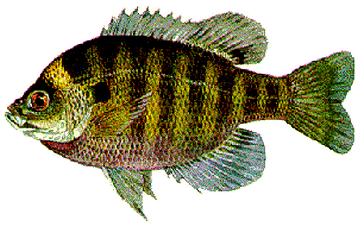|
|
|

Common Names - bream, blue bream, sun perch, blue sunfish, copperhead, copperbelly, roach.
Description - Bluegills have small mouths and oval-shaped, almost rounded, bodies. Body coloration is highly variable with size, sex, spawning, water color, bottom type, and amount of cover. In general, they are somewhat lavender and bronze with about six dark bars on their sides. Males tend to have a copper-colored bar over the top of the head behind the eyes. The breast is silver to slightly blue most of the year, with some yellow or orange during spawing season. Females are generally lighter colored than males. Two distinctive characteristics are the prominent black spot on the rear edge of the gill-cover and a black spot at the base of the posterior portion of the dorsal fin.
Subspecies - Two are recognized: the northern bluegill (Lepomis macrochirus macrochirus), and the Florida bluegill (Lepomis macrochirus mystacalis), found throughout Florida except the panhandle. The bluegill also hybridizes with other members of the sunfish family.
Range - Found throughout the United States because of widespread stocking.
Habitat - Bluegills prefer the quiet, weedy waters where they can hide and feed. They inhabit lakes and ponds, slow-flowing rivers and streams with sand, mud, or gravel bottoms, near aquatic vegetation.
Spawning Habits - Bluegills are well known for "bedding" in large groups, with their circular beds touching one another. Bedding occurs in water two to six feet deep over sand, gravel or mud bottom, often among plant roots. Spawning occurs from April through October with the peak in May and June, when water temperature rises to about 67 degrees. A female may lay 2,000 to 63,000 eggs which hatch 30 to 35 hours after fertilization.
Feeding Habits - Insects, insect larvae and crustaceans are the dominant foods of bluegills, with vegetation, fish eggs, small fish, mollusks, and snails being of secondary importance, although they may dominate their diet during certain times of the year.
Age and Growth - Growth is rapid in Florida. A one-year-old fish may be four inches long. Spawning may occur the first year. Bluegills can live up to 11 years. The rate of growth varies considerably in different bodies of water. However, a six-inch bluegill in Florida is typically two to four years old.
Sporting Qualities - Because of its willingness to take a variety of natural baits (e.g., crickets, grass shrimp, worms) and artificial lures (e.g., small spinners or popping bugs) during the entire year, its gameness when hooked, and its excellent food qualities, the bluegill is one of the more important sport fish in Florida and the eastern United States.
Eating Quality - Excellent; the flesh is white, flaky, firm and sweet. They are generally rolled in cornmeal or dipped in pancake batter before frying. Many rank the bluegill as the most delicious of all freshwater fish.
World Record - 4.75 pounds, caught in Ketona Lake, Alabama, in 1950.